Everyone wants to rank better in search engines for getting more traffic. The more traffic a website gets, the larger one can earn from the blog. SEO plays an important role in improving organic traffic. So, one should always focus on this. In this article, I will explain how you can improve the SEO of your website for ranking well in Google or other search engines. If you have been struggling to rank or struggling to get organic traffic to your website, this in-depth guide will surely help you.
SEO is a long term process. So, you need a proper plan and give Google some time to recrawl and reevaluate your website. That means changes you make will take some time in showing the results. Now when you understand this, here are some ways to improve the SEO of a website.
1. Reduce the website load time
I said this several times in my older blog posts and I am saying it again. The load time of the website is now one of the ranking factors. Google also made it clear back in early 2018 the page speed will be a ranking factor for mobile searches. Google called it ‘Speed Update.’ Now when close to 70% internet traffic originates from mobile devices, you can understand the importance of load time in SEO. Google has also started doing mobile-first indexing. I have already explained it in one of my previous blog posts. You shouldn’t miss that article.
If you really want to check how fast your website loads, use Google’s PageSpeed Insights. This tool shows the score of a webpage for both mobile and desktop. You should focus on both and try to achieve more than 80 score.
See how one of my page scores on PageSpeed Insights.
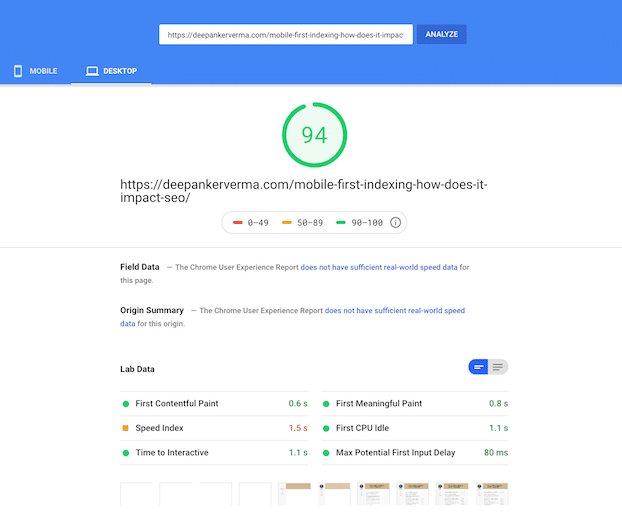
Along with the score, Google also gives how you can further improve the score. So, you know where to work and how to get a better score. here is a sample of suggestions Google offers on the PageSpeed Insights tool.
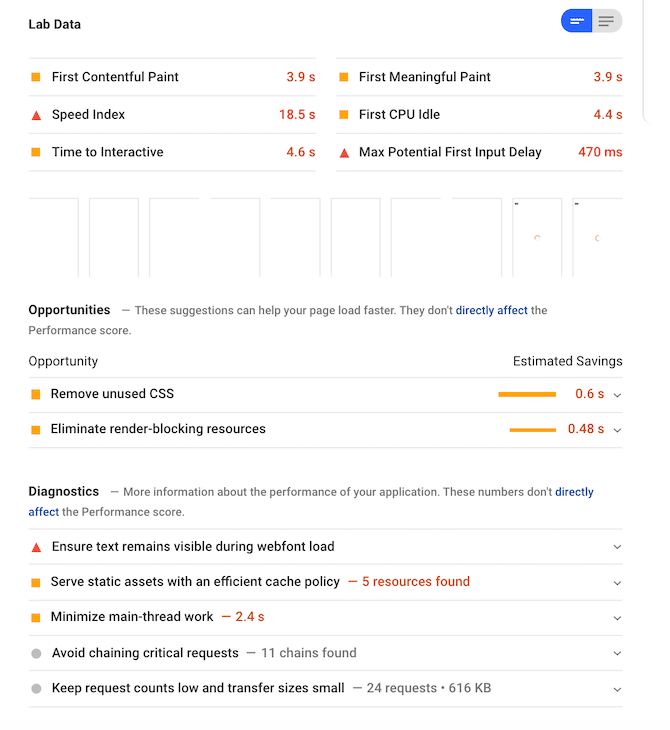
If you want to know more details to understand what is actually impacting the load time and making your website slow, I recommend the use of another tool WebPageTest.org. It also performs tests and shows you in-depth data like how actually the page is loading and what request is making the web page slow.
Here is a snapshot of the result of the same page I used in Google’s PageSpeed Insight tool.
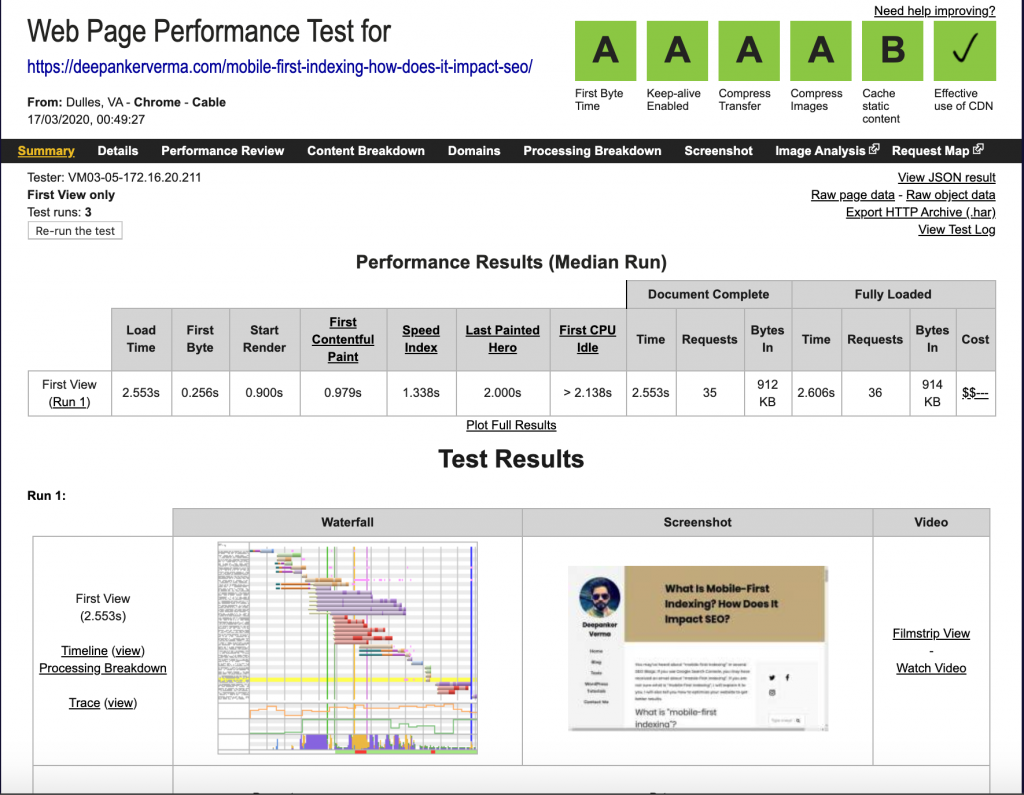
There’s another popular tool from Pingdom for testing the load time of the website. But I personally found WebPageTest.org better and more clear.
For making your blog fast, you should focus on the following things:
1. Use a good web host. I recommend Bluehost.com for beginners. You can see that the First Byte time is important.
2. Use properly sized and compressed images. Properly sized means there is no need to use an image with 3000 pixels width. Resize it to somewhere around 600-800 pixels width. That’s enough. Also, compress images using any good image compressor tool.
3. Use less external scrips. Remove all unnecessary 3rd party scripts. Try to see what plugins you can remove.
4. Use Caching to serves static pages. There are several caching plugins for WordPress to help in this.
If you are using WordPress, I wrote an in-depth guide on how to speed up WordPress blog. You can read that article to understand what you can do. I also offer WordPress speed optimization service. You can hire me if you find it hard to do it by yourself.
2. Reduce bounce rate
There’s a term called Dwell Time. It is the time a person spends on a web page after clicking on the SERP page before clicking back. If someone clicks on your link on SERP and instantly clicks back, it will surely give a negative point to your website and give Google a signal that people hate the web page. Google will drop your ranking for that keyword if more people are bouncing quickly from your website.
So, try to reduce the bounce rate. If you people spend more time on your page, it will give a positive impression. There could be several ways of doing this, but most important is the load time. People click back if a web page takes time to load. Another reason why web page load time is really important.
Along with load time, there could be several reasons to reduce the bounce rate. Another important factor is the content. The more engaging your content is, the lesser the bounce rate will be. If someone clicks on your link but finds content not so good, he will surely click back to check other links in SERP. So, always try to write interesting but SEO-friendly content. Provide better readability, use interlinking and show related posts and popular posts at proper places.
You can embed relevant videos on your page. People like to watch videos more than reading content. If they find a video, they will spend more time watching the video. This results in more time spend on the page. It helps in reducing the dwell time.
I wrote an in-depth guide on how to reduce bounce rate. Read that to know more about this topic in detail.
3. Target right keywords
If you are writing on a topic, it is really important to target the right keywords. Right keywords are those keywords that people actually search to find content. This is where keyword research comes in and you need a good tool for keyword research. As always, I recommend SEMrush for keyword research. Use SEMRush to find out profitable keywords on the topic you are thinking to write.

Then use these keywords in your content. Take care of keyword density. Although there is nothing like an ideal keyword density, try to use those keywords a few times in the content.
See: Best Keyword Research Tools
4. Fix duplicate content
Duplicate content issue negatively impacts the SEO of any website. Google always rewards websites that offer unique site content and penalizes sites with duplicate content. So, you should always try to focus on writing unique and informative content that adds value. There could be several ways how it could impact your website.
If your website is accessible via both https://www.domain.com and https://domain.com, Google will treat them as two different websites with identical content. So, set up the right redirect rules to use one and redirect the second to the primary one.
Check your website properly and see if there are pages with similar content. It shouldn’t be. If you also accept guest posts or pay writers for the content, use plagiarism checker tools to find out if the content or a part of the content was copied from somewhere else.
5. Find Backlink Opportunities
Backlinks play an important role in improving the SEO and page’s authority. So, you should always try to find backlink opportunities. The most common way is broken link building. Broken link building is a way to look for the broken outbound link on a website and then pitch the website owner to fix the broken link by adding a link to your page that has similar content.
You can also use guest posting. Make a list of some good blogs in your niche and ask them if they allow you to write posts for them in return for a link from the author’s bio. This not just gives you backlink but also an exposure among the readers of those blogs where your guest post will go.
You can also use Pinterest, Flipboard, and Quora for some social media links. Even if these links are nofollow, they will help in showing your links to wide viewers.
6. Use original images
Not just unique content, focus on making unique images. You can use Canva for making relevant images to use in your blog posts. If your image is really attractive, other blogs or websites can use it by giving you a link back as a source.
Here is an example of how one of the images got us a backlink from a popular website.
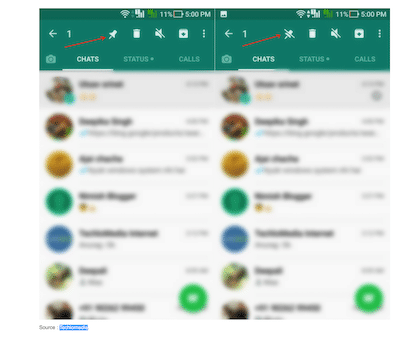
This is without sending any outreach email. Your unique image can be a graph, chart, visualization or table. Focus on creating photos on new trending topics. High-quality photos get easy attention.
7. Use Interlinking
If you look at any Wikipedia page, you see lots of links to several other Wikipedia pages. Wikipedia is a perfect example of how interlinking should be done. Interlinking not just improve in reducing the bounce rate, it also helps in SEO. So, don’t forget to link back your old articles on relevant keywords used on the page. You can also take an example of this page. I have added several links to my other articles.
8. Improve websites structure and design
The website’s theme is really important. It not just gives the primary impression, but the structure of it also affects SEO. As per Google, there should only be one H1 tag on the website. It should be the article title. So, open the source code of any page of your blog and see how many H1 tags are there. If there is more than one, you need to fix it. You should also make sure sidebar wide titles or footer titles are not using the H2 tag. There should only be one H1 tag and H2 tags should only be used within the content. H1 and H2 tags should also contain your keyword. If widget headings will be using H2 tags, it will confuse Google.
Not just heading tag, you should also make sure the theme has proper navigation. So, Google can crawl it in a better way and users can easily find more content on your website.
The theme should also use proper font size and typography to make content easy to read.
Also see: Blogging Tools I Use and Recommend
9. Fix any broken links
Broken links can also impact negatively. So, you should try to find and fix all the broken links on your website. You can use tools like Dead Link Checker to find out dead links on your blog pages. This tool can check your entire website or a specific page. Use as per your needs.
When Google’s bots travel link to link to find new web pages for indexing. If they find a dead link, they won’t be able to go any further from that point. It also wastes link equity and offers poor user experience. So, you should always make sure there are no dead links on your blog.
10. Try to get into Featured snippets
You may have noticed the answer box in Google search results just above the search results showing the full or partial answer to a query. It is called Featured snippet. If a website is in featured snippets, There are high chances of getting clicks many times a website ranking lower gets into a featured snippet and steals the click of website ranking at the top. That means you don’t need to be on the top to be in featured snippets.
Here’s an example of how one of my pages is on Google’s featured snippet.
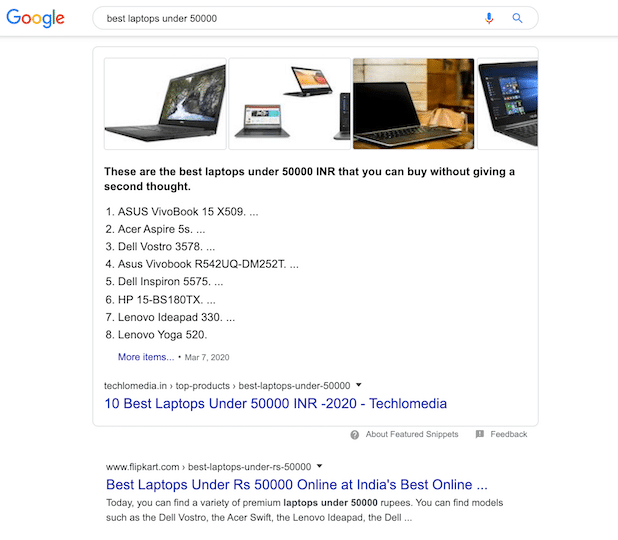
To get into Google’s Featured snippets, you should focus on improving your content. Google mostly shows Definition, Answers, list or table in the featured snippet. So, optimize your content accordingly.
Wrap Up
Now you know what are some ways to improve the SEO of your website. You can follow these SEO strategies to improve your blog and it will surely boost your blog’s ranking in SERP. After you have made the mentioned changes, wait for some time to see the result. Next time when Google recrawls your pages, you will surely see the impact of the changes you have made. Keyword research, content quality and load time are three important things you need to focus on.
I hope this article was useful and valuable. If you really find it interesting, share it with your friends. If you have any questions or doubts, you can always leave a comment below. you can also ask on Twitter or Instagram @deepanker70. I actively reply to people on social media.

Leave a comment